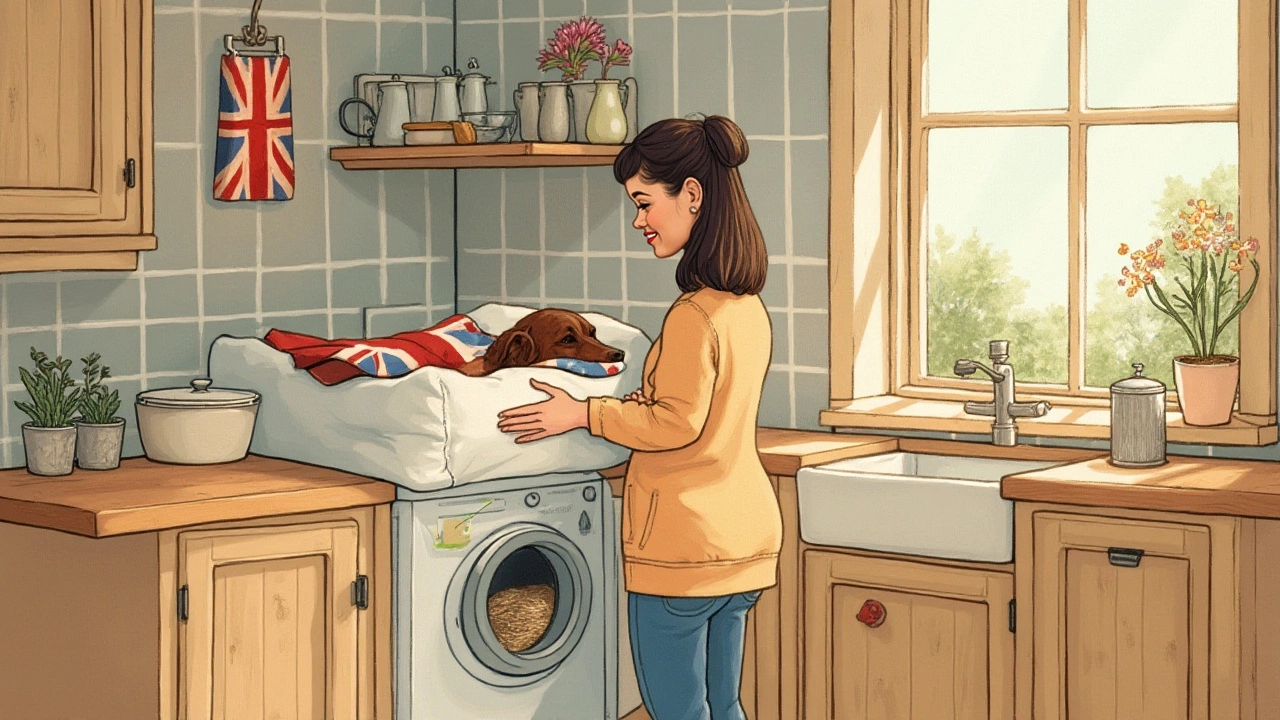Our canine companions bring endless joy into our lives, and ensuring their sleeping space is clean is one of the keys to their happiness. Just as we appreciate fresh sheets, dogs benefit from a tidy bed.
Dog beds accumulate dirt, shed fur, and even unpleasant odors, which can impact their health if neglected. While some dog beds require more frequent laundering than others, it often hinges on a few key factors like your pet's lifestyle and any allergies.
By identifying these factors and following simple cleaning tips, you can keep your dog's resting spot clean, fresh, and comfortable, contributing to their overall well-being.
- Understanding Your Dog's Bedding Needs
- Effects of Unclean Dog Beds
- Ideal Cleaning Frequency
- Tips for Washing Dog Beds
Understanding Your Dog's Bedding Needs
When it comes to ensuring the well-being of your furry friend, recognizing and catering to their pet care and comfort needs is paramount. Each dog, much like humans, has its own set of preferences when it comes to their sleeping environment. Younger dogs or those more prone to anxiety often thrive with beds that provide a snug and cozy experience, offering a sense of security. Senior dogs, on the other hand, may benefit from orthopedic beds designed to support aging joints, reducing discomfort while resting. The choice of material in your dog's bed can also be crucial, not just for comfort, but in aiding cleanliness. Choices range from plush, inviting fabrics that trap heat and provide warmth during colder months, to light, airy options that help with pet hygiene by dissipating excess heat during summer.
Another important factor to consider is whether your dog is an avid adventurer who tends to bring back half the outdoors after every walk. Dogs that spend a lot of time outside need their beds cleaned more frequently due to accumulated dirt and potential pests like fleas and ticks. Regularly washing their dog beds is essential for preventing infestations and maintaining a sanitary sleeping space. Speaking of pests, dogs with allergies require particular attention to their bedding, where allergens like pollen and dust mites can gather unnoticed. A meticulous cleaning routine can alleviate allergic reactions, making daily life much more comfortable.
Knowing your dog’s shedding habits is also instrumental in maintaining pet hygiene. Breeds like Huskies or German Shepherds are known for shedding heavily, meaning their environments can quickly become covered in fur. Frequent vacuuming and choosing a dog bed with a removable, washable cover can greatly ease the maintenance burden. It's not just about cleanliness but also ensuring that your pet enjoys their time to rest and rejuvenate. As the American Kennel Club suggests, "A clean, comfortable bed is critical to a dog's health and comfort."
The type of bed you select should reflect your pet's breed, age, and activity level, ensuring their safety and happiness regardless of where they rest.Ultimately, by understanding these needs, you forge a healthier and happier environment for your beloved pet.

Effects of Unclean Dog Beds
Imagine sliding into bed, accompanied by the stale smell of last week's workout gear mixed with the remnants of last night's dinner. It's not a pleasant thought, right? Yet, this could very well be the scenario your beloved pet experiences if their dog beds aren’t cleaned regularly. A bed riddled with accumulated dirt, fur, and bacteria can significantly impact their health and comfort. Over time, these beds become breeding grounds for fleas and mites, which can lead to relentless scratching and uncomfortable skin conditions. When you factor in dogs' keen sense of smell, a pungent bed can disrupt their sleep cycle, leading to irritability and behavioral issues. Just like us, dogs need a clean space to repose and recharge after a day of adventures, whether it's chasing squirrels or sniffing out the neighborhood news.
In addition to skin-related issues, dirty pet beds hold allergens, creating potential problems, especially for pups with sensitivities. The dust, pollen, and even mold that can gather not only affect your dog's respiratory health but yours as well, as you breathe in the particles that cling to their fur after snooze sessions. The impact isn't limited to physical health. An environment laden with unpleasant smells can affect your dog's emotional well-being too. Dogs rely heavily on their environment's scent to feel secure; thus, a sour-smelling bed could lead to anxiety or stress, which manifest in various forms, from chewing and tearing to frequent pacing.
According to veterinarian Dr. Cheryl Yuill, “Regular washing of your dog’s belongings is essential for reducing environmental allergens, controlling parasites, and maintaining general hygiene.”
Her insights stress the importance of rigorous cleaning routines, especially in households with allergy-prone animals.With regular cleaning, you can also extend the life of the bed, avoiding the frequent expenses of replacing it. A well-maintained bed maintains its shape and support, which is crucial for dogs with joint issues or those in their golden years.
Ultimately, washing your dog’s bed isn’t merely a chore; it's an integral component of responsible pet care. Not only does it benefit your dog directly, but it also contributes to a tidier, healthier home environment. Keep a lookout for signs of an unclean bed, such as frequent scratching, musty areas around the sleeping space, or even changes in your pet’s behavior. By staying vigilant and maintaining a cleaning schedule, you ensure a happier and healthier life for your canine companion.

Ideal Cleaning Frequency
Determining the optimal cleaning frequency for your dog's bed often depends on a blend of factors, including your dog's habits, health conditions, and the type of bed. Just like humans have diverse cleaning needs, our furry friends are no different. A dog with allergies or skin sensitivities may require a more frequent wash schedule to keep allergens and irritants at bay. On the other hand, a non-shedding dog might not necessitate as rigorous a regimen.
To delve into specifics, if your pet spends ample time outdoors, it's crucial to wash their bed weekly. This helps control dirt, debris, and potential insects hitchhiking on their fur. Dogs that tend to drool heavily or have occasional accidents on their dog beds also push for a more frequent wash cycle, as these can quickly lead to unpleasant odors and unhygienic conditions.
"On average, a washing schedule of once a week is sufficient for dogs that shed moderately," suggests Dr. Susan Whitmore, a renowned vet specializing in pet hygiene. "However, pet owners shouldn't shy away from more frequent cleaning whenever necessary."
Let's not forget that fabric type and bed design also play pivotal roles. Beds with removable covers are generally easier to maintain and can efficiently withstand regular washing, while intricate foam beds might require gentle, less frequent care to prevent damage. Maintaining a strict cleaning pattern not only serves health purposes but also extends the life of the bed, maintaining its comfort and support for your pet.
While washing, always adhere to the manufacturer's guidelines for specific cleaning instructions. Some beds might even benefit from a cycle with hypoallergenic detergents, especially if your dog has sensitive skin. Remember, maintaining the hygiene of your pet's bed is as integral a part of their overall grooming routine as regular baths and grooming sessions. By keeping that pet hygiene regime in check, you ensure your dog leads a happy, healthy life, lounging and sleeping on a clean bed fit for a royal companion.

Tips for Washing Dog Beds
Cleaning your dog's bed is an essential aspect of maintaining their health and hygiene. This process, while seemingly straightforward, requires a bit of attention to detail to ensure that you're effectively removing dirt, allergens, and potential parasites. The first step is to check the care label on your dog bed, as different materials require different cleaning methods. Most removable covers can be machine washed, but the filling may need a different approach, such as spot cleaning or hand washing. Additionally, it's crucial to use pet-safe detergents; harsh chemicals can irritate sensitive pet skin or lead to allergic reactions.
When planning your dog bed cleaning schedule, consider your dog's lifestyle and habits. Dogs that spend more time outdoors, or those with thick coats, might bring more dirt and allergens inside, necessitating frequent washing. Experts often recommend washing a dog's bed every two weeks, but weekly could be ideal for homes with multiple pets or family members with allergies. Before beginning the wash, a thorough vacuuming can help reduce fur and dander by removing surface debris. Adding a dash of baking soda before washing can also help neutralize odors naturally, keeping your pet bed smelling fresh longer.
For pet owners dealing with persistent odors or stains, enzymatic cleaners can be incredibly effective. These products break down organic compounds, tackling the root of odors rather than masking them. Let the cleaner sit for a few minutes before washing, ensuring it penetrates deep into the fabric. In some cases, you might need to wash the bed on a higher temperature setting to ensure thorough disinfection, but always confirm this won't damage the material.
According to the American Veterinary Medical Association, “Regular cleaning not only keeps the bed looking and smelling nice but also helps protect your pets from fleas, ticks, and other parasites.”
Drying your pet bed properly is just as important as washing. Mold and mildew can develop if the bed is left damp, posing health risks to your pet care routine. Whenever possible, air-dry the bed in a well-ventilated area with plenty of sunlight, which helps kill remaining bacteria and germs. For quicker drying, a machine dryer on a low setting can be used for covers, but check if the material is suitable. Fluff it occasionally during the drying process to maintain the bed's shape, ensuring your pet has a comfortable retreat.
To recap, a sound approach to maintaining your pet's hygiene involves routine cleaning tailored to their lifestyle and minimizing exposure to irritants. A final handy tip is to have a second bed cover or extra bedding material. This allows you to swap them out for washing without leaving your pet temporarily bedless. Incorporating these cleaning practices not only prolongs the life of the dog bed but also makes it a healthier sanctuary for your canine companion.

